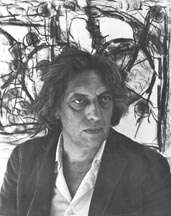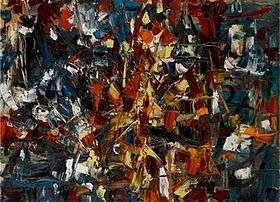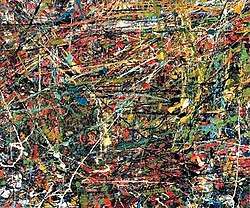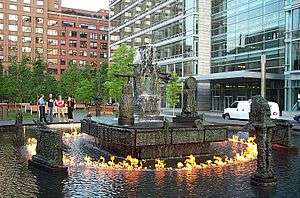Jean-Paul Riopelle
Jean-Paul Riopelle, CC GOQ (7 October 1923 – 12 March 2002) was a painter and sculptor from Quebec, Canada. He had one of the longest and most important international careers of the sixteen signatories of the Refus Global, the 1948 manifesto that announced the Quebecois artistic community's refusal of clericalism and provincialism. He became the first Canadian painter (since James Wilson Morrice) to attain widespread international recognition.[1]
Jean-Paul Riopelle | |
|---|---|
 | |
| Born | October 7, 1923 |
| Died | March 12, 2002 (aged 78) |
| Nationality | Canadian |
| Known for | Painting, Sculpture, Lithography |
| Movement | Les Automatistes Lyrical Abstraction Tachisme |
| Awards | Companion, Order of Canada Grand officer, National Order of Quebec Guggenheim International Award exhibition in 1958 |
Biography
Born in Montreal, Riopelle began drawing lessons in 1933 and continued through 1938. He studied engineering, architecture and photography at the école polytechnique in 1941. In 1942 he enrolled at the École des beaux-arts de Montréal but shifted his studies to the less academic école du Meuble, graduating in 1945.[2]

He studied under Paul-Émile Borduas in the 1940s and was a member of Les Automatistes movement. Breaking with traditional conventions in 1945 after reading André Breton's Le Surréalisme et la Peinture, he began experimenting with non-objective (or non-representational) painting. He was one of the signers of the Refus global manifesto. In 1947 Riopelle moved to Paris and continued his career as an artist, where, after a brief association with the surrealists (he was the only Canadian to exhibit with them)[3] he capitalized on his image as a "wild Canadian". His first solo exhibition took place in 1949 at the Surrealist meeting place, Galerie La Dragonne in Paris.[2]
Riopelle married Françoise Lespérance in 1946; the couple had two daughters but separated in 1953.[4]
In 1959 he began a relationship with the American painter Joan Mitchell.[5] Living together throughout the 1960s, they kept separate homes and studios near Giverny, where Monet had lived. They influenced one another greatly, as much intellectually as artistically, but their relationship was a stormy one, fueled by alcohol.[6] The relationship ended in 1979.[7] His 1992 painting Hommage à Rosa Luxemburg is Riopelle's tribute to Mitchell, who died that year, and is regarded as a high point of his later work.[3]
Work
Riopelle's style in the 1940s changed quickly from Surrealism to Lyrical Abstraction (related to abstract expressionism), in which he used myriad tumultuous cubes and triangles of multicolored elements, facetted with a palette knife, spatula, or trowel, on often large canvases to create powerful atmospheres.
The presence of long filaments of paint in his painting from 1948 through the early 1950s[8] has often been seen as resulting from a dripping technique like that of Jackson Pollock. Rather, the creation of such effects came from the act of throwing, with a palette knife or brush, large quantities of paint onto the stretched canvas (positioned vertically).[9][10][11]
Riopelle's voluminous impasto became just as important as color. His oil painting technique allowed him to paint thick layers, producing peaks and troughs as copious amounts of paint were applied to the surface of the canvas. Riopelle, though, claimed that the heavy impasto was unintentional: "When I begin a painting," he said, "I always hope to complete it in a few strokes, starting with the first colours I daub down anywhere and anyhow. But it never works, so I add more, without realizing it. I have never wanted to paint thickly, paint tubes are much too expensive. But one way or another, the painting has to be done. When I learn how to paint better, I will paint less thickly."[10]

When Riopelle started painting, he would attempt to finish the work in one session, preparing all the color he needed beforehand: "I would even go as far to say—obviously I don't use a palette, but the idea of a palette or a selection of colors that is not mine makes me uncomfortable, because when I work, I can't waste my time searching for them. It has to work right away."[10][12]
A third element, range of gloss, in addition to color and volume, plays a crucial role in Riopelle's oil paintings. Paints are juxtaposed so that light is reflected off the surface not just in different directions but with varying intensity, depending on the naturally occurring gloss finish (he did not varnish his paintings). These three elements; color, volume, and range of gloss, would form the basis of his oil painting technique throughout his long and prolific career.[10]
Riopelle received an Honorable Mention at the 1952 São Paulo Art Biennial.[13] In 1953 he showed at the Younger European Painters exhibition at the Solomon R. Guggenheim Museum in New York City.[14] The following year Riopelle began exhibiting at the Pierre Matisse Gallery in New York. In 1954, works by Riopelle, along with those of B. C. Binning and Paul-Émile Borduas represented Canada at the Venice Biennale. He was the sole artist representing Canada at the 1962 Venice Biennale in an exhibit curated by Charles Comfort.[15] Riopelle received an Honorable Mention at the Guggenheim Museum’s Guggenheim International Award exhibition in 1958 and a major retrospective of his work was held at the Kölnischer Kunstverein, Cologne. Subsequent retrospectives of Riopelle’s work were held at the National Gallery of Canada in 1963, a smaller exhibition at the Musée du Québec in 1967, at the Fondation Maeght (Saint Paul-de-Vence, France) in 1971, and at the Musée d’Art Moderne de la Ville de Paris in 1972.[16][17] He was made a member of the Royal Canadian Academy of Arts.[18]

After diversifying his means of expression during the 1960s (turning to ink on paper, watercolours, lithography, collage and oils), he experimented with sculptural installations, including a fountain in Montreal's Olympic Stadium, called La joute. In 1972 he returned to Québec and built a studio at Sainte-Marguerite-du-Lac-Masson. He discovered the black and white landscapes of the Great North, inspiring in the Icebergs series of 1977 and 1978.[3] A large retrospective of Riopelle's work was held in 1981 at the Musée National d'Art Moderne, Centre Georges Pompidou, in Paris, then traveled to the Musée national des beaux-arts du Québec and Musée d'art contemporain de Montréal, 1981-1982. This exhibit also travelled to the Museo de Arte Moderno in Mexico City, the Museo de Arte Contemporáneo de Caracas, Venezuela in Caracas.[19]
While expressing more representational subject matter in the 1980s, he abandoned traditional painting methods in favor of aerosol spray cans. In 1981 he became the first signatory of the Refus Global manifesto to be awarded the prestigious Prix Paul-Émile-Borduas.[20] His painting Hommage à Rosa Luxemburg (1992) is a tribute to love, to the American painter Joan Mitchell who was his companion for 25 years. Riopelle established his studios at Estérel, Quebec, but lived his last years at Isle-aux-Grues, an isolated island situated in the St. Lawrence River.[3]
Riopelle was arguably one of the most important Canadian artists of the 20th century, establishing his reputation in the burgeoning postwar art scene of Paris, where his entourage included André Breton, Sam Francis and Samuel Beckett. Riopelle produced over six thousand works (of which he produced more than two thousand paintings) during the course of his lifetime.[10]
Art market
On May 24, 2017 Riopelle's painting Vent du nord sold at the Heffel Fine Art Auction House spring auction for $7,438,750 (CAD) (including buyer's premium), the second-highest price to date for a Canadian work of art.[21][22] Heffel holds the current record for Riopelle's work.
Relocation of La Joute
Riopelle's 1969 work La Joute was originally located in the Parc Olympique, in the Hochelaga-Maisonneuve district of Montreal. The work is an homage to his boyhood hockey heroes.[3] Its relocation to the La Place Jean-Paul-Riopelle during the redevelopment of the Quartier international de Montréal in 2003 provoked controversy and outrage from residents of Hochelaga-Maisonneuve, who claimed that moving it from the Parc Olympique deprived it of the context required for its full meaning as an homage to sport.
Those who supported the move, including the Quebec government, Riopelle's heirs, and the artwork's owner the Musée d'art contemporain de Montréal, argued that moving it would allow a proper homage to Riopelle, and that it would allow the work to be more widely seen and exhibited as the artist intended, whereas its previous location had been inaccessible and had not included the fountain or fire elements Riopelle designed.[23]
Theft and Destruction of La Défaite
On August 1, 2011, Riopelle's sculpture La Défaite was stolen from its pedestal in Esterel, QC, where it had been on display since 1963. The sculpture was found the next day in a wooded area, broken into four pieces.[24]
Legacy
Riopelle represented Canada at the 1962 Venice Biennale. In 1969 he was made a Companion of the Order of Canada, and began to spend more time in Canada. He was specially recognized by UNESCO for his work. One of his largest compositions, Point de rencontre, was originally intended for the Toronto airport, but is now in the Opéra Bastille in Paris. In 1988 he was made an Officer of the National Order of Quebec and was promoted to Grand Officer in 1994. In 2000 Riopelle was inducted into Canada's Walk of Fame.
In June, 2006 the Montreal Museum of Fine Arts organized a retrospective exhibition which was presented at the State Hermitage Museum in Saint Petersburg, Russia and the Musee Cantini in Marseilles, France. The Montreal Museum of Fine Arts has a number of his works, spanning his entire career, in their permanent collection.
A set of postage stamps depicting portions of Riopelle's painting L'Hommage à Rosa Luxemburg was issued by Canada Post on Oct. 7, 2003.[25]
Works
 La Place Jean-Paul-Riopelle, Montreal, Quebec
La Place Jean-Paul-Riopelle, Montreal, Quebec Jean-Paul Riopelle's star on Canada's Walk of Fame
Jean-Paul Riopelle's star on Canada's Walk of Fame- La Place Jean-Paul Riopelle in Quartier international de Montréal, Quebec
 La Place Jean-Paul Riopelle in Quartier international de Montréal, Quebec
La Place Jean-Paul Riopelle in Quartier international de Montréal, Quebec
References
- Tate, London, Artist Biography
- National Gallery of Canada
- The Canadian Encyclopedia
- "Fonds Françoise Riopelle" (in French). Bibliothèque et Archives nationales du Québec.
- Jane Livingston, The Paintings of Joan Mitchell, New York: Whitney Museum of American Art, 2002, p. 24
- Jane Livingston, The Paintings of Joan Mitchell, New York: Whitney Museum of American Art, 2002, p. 26
- Jane Livingston, The Paintings of Joan Mitchell, New York: Whitney Museum of American Art, 2002, p. 25
- Art Gallery of New South Wales, Sydney, Australia
- Agence photographique de la réunion des Musées nationaux, Riopelle in his studio
- Jean Paul Riopelle: The Artist's Materials, Marie-Claude Corbeil, Kate Helwig, Jennifer Poulin, Getty Publications, Dec. 20, 2011
- Pierre Letarte and Marianne Feaver, 1982, in Riopelle vu par..., Texts and interviews gathered by Michel Waldberg, 2004, Centre culturel canadien.
- Riopelle in conversation, Gilbert Erouart; with an interview by Fernand Séguin; translated by Donald Winkler,, 1995, pp 79-80
- Galerie Lelong, Riopelle Exhibitions 1951-2011
- Solomon R. Guggenheim Museum, New York, Younger European painters: a selection, exhibition catalogue, 2 December 1953 - 21 February 1954, pp. 22-23
- "Past Canadian Exhibitions". National Gallery of Canada at the Venice Biennale. National Gallery of Canada. Archived from the original on 13 October 2013. Retrieved 12 October 2013.
- Peggy Guggenheim Collection, Riopelle biography
- Michael Greenwood, Jean-Paul Riopelle: Iceberds, May-June 1979
- "Members since 1880". Royal Canadian Academy of Arts. Archived from the original on 26 May 2011. Retrieved 11 September 2013.
- Jean-Paul Riopelle: Peinture 1946-1977: Musée National d'Art Moderne, Centre Georges Pompidou, Paris 30 September - 16 November 1981, Musée Du Quebec, 9 December 1981 - 24 January 1982, Musée D'Art Contemporain, Montreal, 16 July - 22 August 1982
- Prix Paul-Émile-Borduas 1981, Riopelle, Jean-Paul
- "Jean Paul Riopelle painting sells for more than $7.4M". CBC. The Canadian Press. May 24, 2017. Retrieved May 25, 2017.
- Jean Paul Riopelle masterpiece smashes world record at Heffel live auction, Heffel Fine Art Auction House
- Lamarche, Bernard (2002-04-19). "La Joute au Stade olympique - Le Riopelle doit déménager pour assurer sa préservation". Le Devoir (in French). Retrieved 2008-03-20.
- CBC News (2 August 2011). "Stolen Riopelle Statues Worth $1Million Found Broken". Retrieved August 2, 2011.
- "Jean-Paul Riopelle". Canada Post. Archived from the original on 17 October 2013. Retrieved 13 October 2013.
Bibliography
- Livingston, Jane, Joan Mitchell, Linda Nochlin and Yvette Y. Lee. The Paintings of Joan Mitchell. New York: Whitney Museum of American Art, 2002. ISBN 0-520-23570-3
- Guy Robert, Riopelle ou la poétique du geste, Éditions de l'homme, Montréal, 1970
- Pierre Schneider (historien), Riopelle, Signes mêlés, Maeght Éditeur, Paris, 1972
- Pierre Schneider(historien), Preface of exhibition catalogue, Jean-Paul Riopelle, Paris, Musée National d'Art Moderne, 1981
- Guy Robert, Riopelle chasseur d'images, Éditions France-Amérique, Montréal, 1981
- Daniel Gagnon, Riopelle grandeur nature, Fides, Collection Approches, Montréal, 1988
- Jean-Paul Riopelle, D'hier et d'aujourd'hui, Fondation Maeght, 1990
- Riopelle, exhibition catalogue, Musée des beaux-arts de Montréal, 1991
- Entretiens avec Jean-Paul Riopelle; suivis de Fernand Seguin rencontre Jean-Paul Riopelle, Édition Liber, collection de vive-voix, Montréal, 1993
- Hélène de Billy, Riopelle, Édition Art Global, Montréal, 1996
- René Viau, Jean-Paul Riopelle, Édition Musée du Québec, 2003
- Lise Gauvin, Chez Riopelle, Visites d'Atelier, Éditions de L'Hexagone, 2005, Montréal
- Yseult Riopelle, Catalogue raisonné de Jean-Paul Riopelle, Tome 1, 1939-1953, Hibou Éditeurs, Montréal, 1999
- Yseult Riopelle, Catalogue raisonné de Jean-Paul Riopelle, Tome 2, 1954-1959, Hibou Éditeurs, Montréal, 2004
- Yseult Riopelle, Catalogue raisonné des estampes de Jean-Paul Riopelle, Hibou Éditeurs, Montréal, 2005
- Yseult Riopelle, Tanguy Riopelle, Catalogue raisonné de Jean-Paul Riopelle, Tome 3, 1960-1965, Hibou Éditeurs, Montréal, 2009
- Yseult Riopelle, Tanguy Riopelle, François-Marc Gagnon, Catalogue raisonné de Jean Paul Riopelle Tome 4, 1961-1971, Hibou Éditeurs, Montréal, 2014
External links
- The Art Institute of Chicago
- Hirshhorn Museum and Sculpture Garden, Washington D.C.
- National Galleries of Scotland, Edinburgh
- National Gallery of Canada, Ottawa
- Brooklyn Museum, New York City
- Los Angeles County Museum of Art, LACMA, Database
- Musée des Beaux-Arts de Montréal, Québec
- Musée national des beaux-arts du Québec, Quebec City
- The Metropolitan Museum of Art, New York
- Record price for Riopelle painting at a public auction, Christie's Paris, 1 June 2012
| Wikimedia Commons has media related to Jean-Paul Riopelle. |